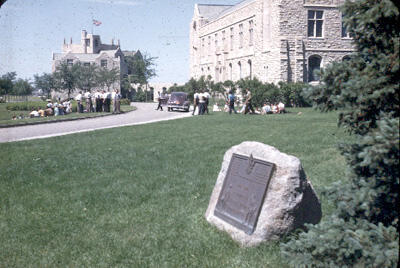
Title and statement of responsibility area
Title proper
Campus - Scenic
General material designation
- Graphic material
Parallel title
Other title information
Title statements of responsibility
Title notes
Level of description
Item
Reference code
Edition area
Edition statement
Edition statement of responsibility
Class of material specific details area
Statement of scale (cartographic)
Statement of projection (cartographic)
Statement of coordinates (cartographic)
Statement of scale (architectural)
Issuing jurisdiction and denomination (philatelic)
Dates of creation area
Date(s)
-
1947 (Creation)
Physical description area
Physical description
1 slide : col. ; 5 x 5 cm
Publisher's series area
Title proper of publisher's series
Parallel titles of publisher's series
Other title information of publisher's series
Statement of responsibility relating to publisher's series
Numbering within publisher's series
Note on publisher's series
Archival description area
Name of creator
Custodial history
Scope and content
Looking west along the edge of the Bowl with Physics and Chemistry buildings in background. 46th Battalion C.E.F. Memorial Stone visible at far right.
Bio/Historical Note: A memorial stone and plaque honouring the memory of those who served with the 46th Canadian Infantry Battalion (South Saskatchewan), Canadian Expeditionary Force, 1914-1918, sits under a tree on the northeast corner of the Bowl. Formed in February of 1915, the 46th battalion was filled primarily with Saskatchewan youths, many via USask. Also known as the "suicide battalion,” it fought in some of the bloodiest encounters of the war. Of the 5,374 men in the 46th battalion, 4,917 were either killed or wounded. A particularly costly battle was Passchendaele, where there were 403 casualties from the battalion's strength of 600 men. With the end of the war came demobilization and the end of the 46th Battalion. The soldiers became veterans and returned to civilian life. Many re-enrolled or entered the university for the first time. Many others did not return. The Memorial Stone was unveiled 11 November 1933 and was designed by Ms. M.J. Taylor of Winnipeg.
Notes area
Physical condition
Immediate source of acquisition
Arrangement
Language of material
Script of material
Location of originals
Availability of other formats
Restrictions on access
Terms governing use, reproduction, and publication
Photographer: Unknown
Other terms: Researcher responsible for obtaining permission
Finding aids
Associated materials
Accruals
General note
See also S-326.

